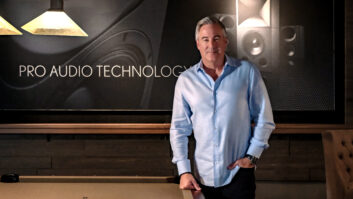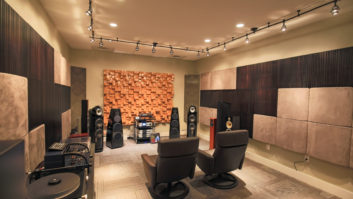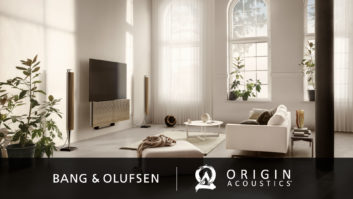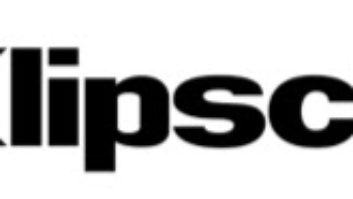Last month I wrote a post titled, “How I learned to stop worrying and love the soundbar,” a play on the Dr. Strangelove title. That post detailed all of the reasons why I used to be prejudiced toward soundbars, and why we didn’t really capitalize on that segment of the market. But our company finally came around and realized that there is a real place in the custom installation world for soundbars for a variety of reasons.
In truth, there is probably no market segment with as much growth potential for custom integrators as the soundbar, and if you aren’t capitalizing on it, you are likely leaving money on the table. Money that other integrators (or big box stores) are going to be more than happy to pick up. People are buying more and more flat-panel TVs, which have worse and worse sound. This is a perfect technological storm, and the soundbar can be the shelter.
In the past month, I’ve sold five of Definitive Technology’s flagship Mythos SoloCinema XTR soundbars for $2,000 each. While $2,000 would likely represent the most entry-level surround sound package that your company offers, it is definitely at the upper end of the soundbar market, especially when you consider that most people walking into our store mention the $200-$400 other bars they have been looking at. Since we’ve really embraced soundbars on the floor, I’ve come up with my sales patter and routine that makes for a really smooth—and successful—demonstration.
Advertise It
For the past month we’ve had this up on the reader board on our marquee in front of our store:

I can’t tell you how many people have come in specifically because of that sign. And when they come in asking about high-performance soundbars, you have already qualified them as someone that is looking for something better than the usual low-end stuff that is out there. (Another great attention grabber for the reader board? “Control your entire home with an iPad.”)
Display It
Obviously this is more applicable to companies with a dedicated showroom, but if you plan on selling a high-end soundbar, you need to believe in it enough to have it out on display. We have the Definitive set up in a system right when you walk into our store. People can see it, touch it, imagine what it would look like installed into their home, etc. They can also see how incredibly thin it is, and how it will match up with their flat-panel TV. They can also compare the build quality and the fit-and-finish with the other cheap bars they have seen elsewhere. I like to point their attention to the wireless subwoofer and make them feel the heft of it, explaining the build quality and that this is a “real” subwoofer and not just some cheap add-on bass box.
Explain It
Whatever high-end bar you choose to sell—Yamaha, GoldenEar Technology, Martin Logan, Paradigm, B&W—there will be some features that make it your standout choice. Is it the sound quality, the surround effect, or the look and design? For the Definitive Technology, I like to point out that it has three HDMI inputs and that it is one of the few bars out there that can actually process Dolby TrueHD and DTS HD-Master audio. I explain that going with this bar doesn’t mean compromising and missing out on the next-gen audio soundtracks from Blu-ray discs. I feel that the Definitive offers a really encompassing sound field, putting sounds well to the sides of the listening position. It also offers one of the best packaged wireless subs of any of the bars I’ve heard. Whatever reasons you have for choosing the bar that you did, explain these highpoints to customers so they can appreciate why this is a premium product and worth a premium price.
Demonstrate It
By this point, the person is generally pretty excited to actually hear the bar in action. So I sit them in a chair and explain that I would like to demonstrate how amazing it sounds. The first thing I pull up is a movie to highlight the dynamics and surround effect of the bar. I use the “A Surprise Attack” scene from Master and Commander: The Far Side of the World. This scene is just under four minutes long, so it’s long enough to feel substantial but not so long that they start to get antsy. This scene also has a ton of ambient wind and water noise, sails rustling and footsteps clomping around above you, voices off in the distances and also some big cannon blasts that show off the sub’s performance. Also, while it has some good action, it isn’t too brutal. (I used to demo a clip from Terminator 2 until some elderly woman walked out saying, “That is just awful! Who on earth would want to watch that?!?”) I explain that I want them to listen for all of these ambient effects and how wide the sounds go beyond the speaker.
Then, I play the scene. Honestly, by the time this clip is over, most people are ready to buy. I’ve had clients say things like, “Oh my God! I can’t believe a soundbar can actually sound this good!” and, “Are you saying that all of that sound came from just that one speaker?!” and, “I came in to spend $1,000, but now there is no way I could buy anything else.”
Next, I demo some television audio for them. I preface the demo by saying that the speakers in modern TVs are really terrible and that it makes it really difficult to understand dialog and that since they are probably going to be watching more TV than movies, I want them to hear how great it sounds when watching TV. So I ask what kinds of programs they watch, and then I’ll flip to something like ESPN, or CNBC, or History Channel and just let them listen to TV dialog for a bit to experience how much clearer the dialog is. I also hand them the remote control and let them adjust the level of the dialog with the Center +/- button, showing them how easy it is to make changes.
Finally, I explain that part of being a great speaker is the ability to play back music as well. So I call up the album cover art screen on our Kaleidescape and ask them to pick some music that they like. We scroll through our list of albums until they find something they like and then we listen to a song.
Validate It
When I’ve finished with the demo, I then explain why I feel the soundbar is the right system for them. When you consider that a “traditional” home theater system includes 5.1 speakers and a receiver and wiring and labor, the $2,000 price point and simplicity of installation makes the bar seem like a relative value.
Close It
“So, what do you think?” This open-ended question gets them talking, and generally by this point they have made the decision to purchase the bar. If they think it is too expensive, I can try to overcome that objection or offer to show them a lower priced solution. (We also have the Bose CineMate1 SR on display. Usually after hearing this, they decide that the extra money for the Definitive is worth it and we go and write it up. If they like the Bose, I write that up. Win-win.) Not everyone walks out buying, but everyone walks out with their expectations of what a soundbar can sound like seriously raised. This makes it a lot harder for them to go anywhere else and be impressed, meaning they’ll usually return to make the purchase from me.
John Sciacca is principal of Custom Theater and Audio in Myrtle Beach, SC.







